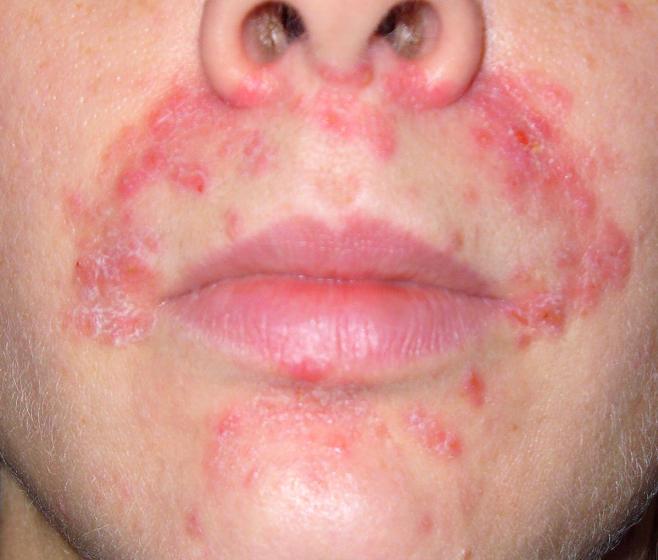Perioral Dermatitis Symptoms, Causes, Diagnosis and Treatment

What Is Perioral Dermatitis?
It is a skin disease marked by small vesicles, pustules and papules that form on the perioral skin (skin surrounding the mouth), perioccular area (surrounding the eyes) or nasolabial or perinasal folds (surrounding the nostrils).
In addition to this, perioral dermatitis commonly targets females between 20-45 years of age. However it can also affect elderly, men and children. The condition is common, whilst people who have suffered it once are more prone to contract it again.
What Are The Symptoms Of Perioral Dermatitis?
Few common symptoms of perioral dermatitis include:
- Formation of bumps around your mouth. These bumps can be pus or fluid-filled.
- Burning sensation around your mouth.
- Such rash can also form around your forehead, nose or eyes.
Moreover, rash associated with perioral dermatitis may seem like acne, however itching is uncommon.
When Is The Right Time To Seek Medical Assistance?
In case you have developed red rashes around the mouth that have failed to heal in 3-4 days, then, do not follow the wait-and-watch approach. Immediately call up for an appointment with your health care provider.
What Causes Perioral Dermatitis?
What actually causes the skin condition is unknown; however, usually it occurs due to the usage of topical steroid on the face.
Besides, there are several potential causes that can trigger perioral dermatitis, these include:
- Certain medications.
- Chewing gum.
- Autoimmune disease.
- Hormonal changes.
- Allergies to some ingredients used in specific dental products.
- Lip licking/ chewing/sucking.
How Is Perioral Dermatitis Diagnosed?
Often, the diagnosis of the skin condition is done on the basis of rash and its characteristics. Typically, skin biopsy is not needed for its diagnosis, however can be needed to rule out some other diseases of the skin that may mimic the symptoms of perioral dermatitis. These skin diseases are seborrheic dermatitis, acne vulgaris, rosacea, irritant contact dermatitis and allergic contact dermatitis.
How Is Perioral Dermatitis Treated?
In usual instances, the skin condition tends to resolve on its own within several months. It is important to discontinue the usage of topical corticosteroid entirely. Some medications have proved to pace the recovery, these include:
- Pimecrolimus.
- Metronidazole.
- Clindamycin.
- Tacrolimus.
- Sodium sulfacetamide with sulfur.
- Benzoyl peroxide.
- Erythromycin.
In case the condition is severe, then the doctor will prescribe a course of antibiotics. He or she will possibly use any of the following antibiotics:
- Erythromycin.
- Minocycline.
- Doxycycline.
- Tetracycline.
What Is The Prognosis Of Perioral Dermatitis?
The skin condition needs continuous treatment for months. Symptoms often reappear. Chances of its recurrence increase in case of applying steroid-containing creams on the face.
What Is The Prevention Of Perioral Dermatitis?
In order to avoid perioral dermatitis, it is strictly advice to avoid applying creams on the face that contains steroids, unless it is directed by a dermatologist.
Related Articles :
Mastitis Symptoms, Causes, Diagnosis and Treatment
Syphilis Symptoms, Causes, Diagnosis and Treatment
Rosacea Symptoms, Causes, Diagnosis and Treatment
Dermatitis Herpetiformis Symptoms, Causes, Diagnosis and Treatment
Chancroid Symptoms, Causes, Diagnosis and Treatment
Bullous Pemphigoid Symptoms, Causes, Diagnosis and Treatment
Mammary Duct Ectasia Symptoms, Causes, Diagnosis and Treatment
Lupus Symptoms, Causes, Diagnosis and Treatment
Lichen Sclerosus Symptoms, Causes, Diagnosis and Treatment
Lichen Nitidus Symptoms, Causes, Diagnosis and Treatment
Leprosy Symptoms, Causes, Diagnosis and Treatment
Latex Allergy Symptoms, Causes, Diagnosis and Treatment
Jock Itch Symptoms, Causes, Diagnosis and Treatment
Ringworm Symptoms, Causes, Diagnosis and Treatment
Roseola Symptoms, Causes, Diagnosis and Treatment
By : Natural Health News




